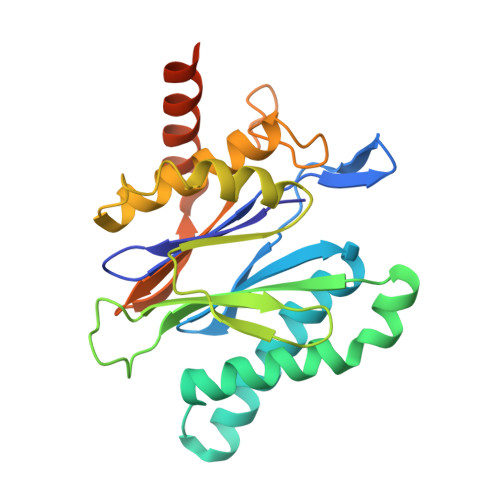Structure of the Mycobacterium tuberculosis proteasome and mechanism of inhibition by a peptidyl boronate.
Hu, G., Lin, G., Wang, M., Dick, L., Xu, R.M., Nathan, C., Li, H.(2006) Mol Microbiol 59: 1417-1428
- PubMed: 16468986
- DOI: https://doi.org/10.1111/j.1365-2958.2005.05036.x
- Primary Citation of Related Structures:
2FHG, 2FHH - PubMed Abstract:
Mycobacterium tuberculosis (Mtb) has the remarkable ability to resist killing by human macrophages. The 750 kDa proteasome, not available in most eubacteria except Actinomycetes, appears to contribute to Mtb's resistance. The crystal structure of the Mtb proteasome at 3.0 A resolution reveals a substrate-binding pocket with composite features of the distinct beta1, beta2 and beta5 substrate binding sites of eukaryotic proteasomes, accounting for the broad specificity of the Mtb proteasome towards oligopeptides described in the companion article [Lin et al. (2006), Mol Microbiol doi:10.1111/j.1365-2958.2005.05035.x]. The substrate entrance at the end of the cylindrical proteasome appears open in the crystal structure due to partial disorder of the alpha-subunit N-terminal residues. However, cryo-electron microscopy of the core particle reveals a closed end, compatible with the density observed in negative-staining electron microscopy that depended on the presence of the N-terminal octapetides of the alpha-subunits in the companion article, suggesting that the Mtb proteasome has a gated structure. We determine for the first time the proteasomal inhibition mechanism of the dipeptidyl boronate N-(4-morpholine)carbonyl-beta-(1-naphthyl)-L-alanine-L-leucine boronic acid (MLN-273), an analogue of the antimyeloma drug bortezomib. The structure improves prospects for designing Mtb-specific proteasomal inhibitors as a novel approach to chemotherapy of tuberculosis.
Organizational Affiliation:
Biology Department, Brookhaven National Laboratory, 50 Bell Avenue, Upton, NY 11973, USA.















